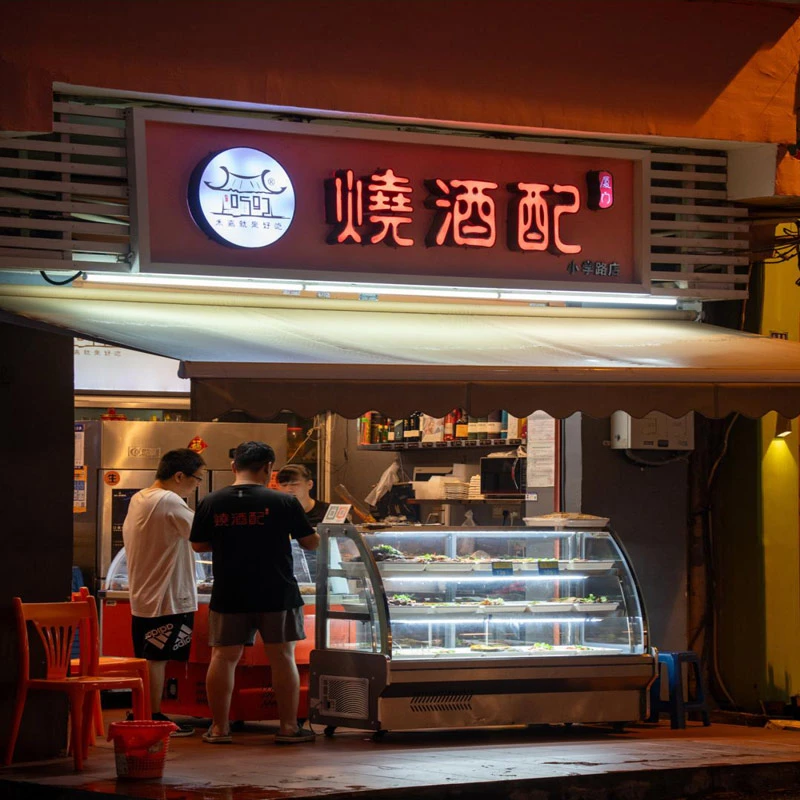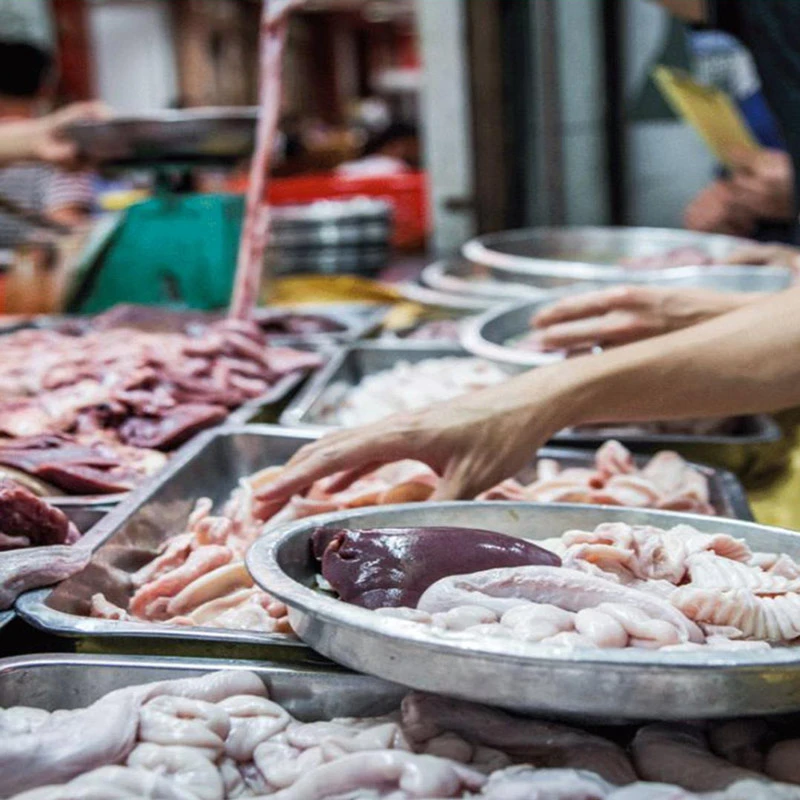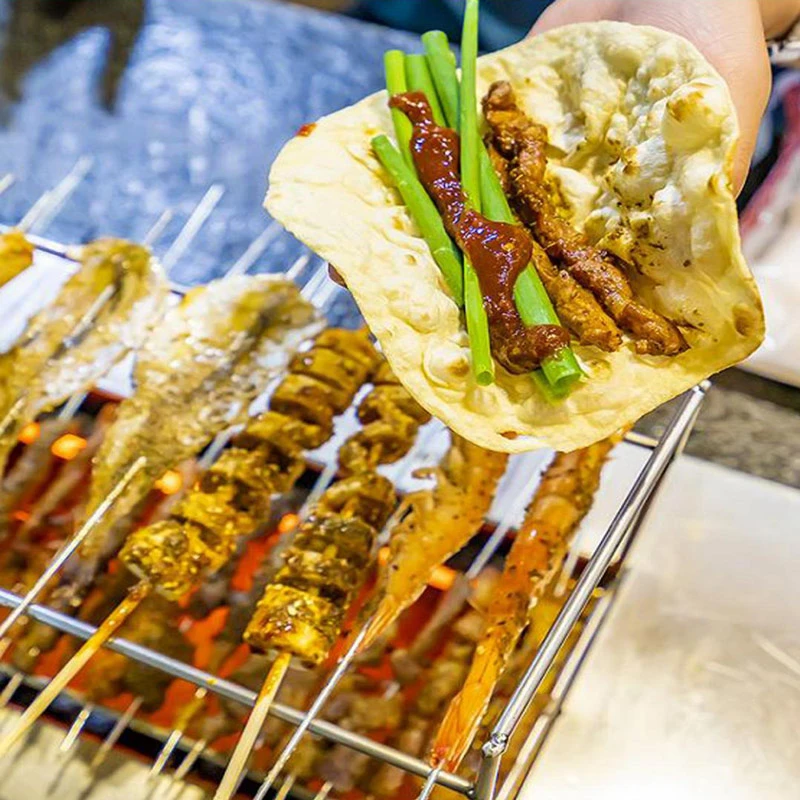The Symphony of Street Dining
When I think of Da Pai Dang (大排挡), the first thing that comes to mind isn't the taste or the food, but the sound. The vibrant, layered cacophony is what defines the experience. Imagine sitting at a battered plastic table on a warm summer night, and the city's nightscape unfolds around you in a symphony of sounds. First, you hear the distant hum of traffic, ebbing and flowing like the lifeblood of the urban night. Then, the beat of square dance music, both traditional and pop, blends into a rhythmic pulse that seems to ripple through the city. Amidst this, you might catch the occasional chirp of a cicada, valiantly trying to assert itself against the overwhelming human presence.
The true magic begins when the chef ignites the stove. The roar of the flames as they leap up to greet the wok is swiftly followed by the clanging of metal—a spatula rhythmically striking the wok's edge, as ingredients tumble into hot oil with a sharp hiss. This auditory feast is as transient as it is intense; soon, the wok is lifted, and the dish is plated. As you sit back and listen, the final layer of sound emerges: the clinking of chopsticks breaking through plastic wrappings, the pop of beer bottles being opened, and the dull thud of dishes landing on the table. These are the sounds of Da Pai Dang, the essence of a dining culture that is noisy, oily, and unapologetically lively.

The story of Da Pai Dang is one of resilience, adaptation, and cultural significance. It started as a modest street food tradition in Hong Kong and has since spread across China, leaving its mark on cities and their culinary identities. From the delicate stir-fries of Cantonese cuisine to the fiery pots of Chongqing's Jianghu cuisine, Da Pai Dang has proven that it is more than just a dining option—it is a cultural phenomenon.
In recent years, as China's food culture continues to gain global recognition, there has been a growing call to officially recognize Da Pai Dang as the "ninth cuisine (第九大菜系)" of China. This recognition would be more than just a label; it would be a celebration of a tradition that has fed millions, nurtured communities, and shaped the culinary landscape of an entire nation.
The History of Da Pai Dang
To understand what Da Pai Dang truly represents, we must trace its origins. The term originated in Hong Kong during the 1930s and 1940s when the British colonial government issued large licenses to street vendors, allowing them to operate fixed stalls along the streets. These licenses were prominently displayed, giving rise to the name "Da Pai Dang" (literally "big license stall"). Though the name may evoke grand imagery, Da Pai Dang was anything but luxurious. It was born out of necessity, a small-scale, family-run operation often consisting of just a couple of tables and a makeshift kitchen on wheels.
Over the decades, Da Pai Dang evolved, especially in Hong Kong, where it became synonymous with quick, affordable, and delicious meals. The dishes served were simple but required skill to execute, particularly the iconic "wok hei (锅气)" or the breath of the wok—a flavor that can only be achieved through expert stir-frying techniques. The cuisine at these stalls was deeply rooted in Cantonese traditions, with signature dishes like stir-fried beef noodles and salt-and-pepper squid becoming staples.
As Hong Kong's economy soared in the 1970s, the government began phasing out these street vendors in an attempt to clean up the city's image. Yet, the spirit of Da Pai Dang was far from extinguished. It persisted in the narrow alleys and hidden corners of the city, preserving a slice of local culture that has become a cherished memory for many.
The Cultural Tapestry of Da Pai Dang Across China
Da Pai Dang didn't just stay in Hong Kong; it traveled, adapted, and thrived in different regions of China, each adding its own flavor to the concept. In Guangzhou, during the 1980s, the economy was booming, and Da Pai Dang grew rapidly, becoming an integral part of the city's nightlife. The locals embraced these stalls for their affordability and the communal experience they offered.
Moving north to Wuhan, a city known for its bustling markets and lively street culture, Da Pai Dang flourished in the 1990s. The city's infamous Jiqing Street became the epicenter of this culture, immortalized in literature and film. The street was more than just a place to eat; it was a living, breathing embodiment of the city's spirit, where the flavors of street food mingled with the sounds of street performers, creating an atmosphere that was as much about entertainment as it was about sustenance.
In the modern era, cities like Chengdu, Chongqing, and Changsha have put their own spin on Da Pai Dang, blending it with the fiery flavors of Sichuan and Hunan cuisines. The concept of "Jianghu cuisine (江湖菜)" in Chongqing, with its bold, spicy dishes, mirrors the ethos of Da Pai Dang—unpretentious, hearty, and deeply satisfying. These regions have taken the idea of Da Pai Dang and woven it into their culinary traditions, ensuring that it continues to evolve while staying true to its roots.
Da Pai Dang is not just about the food; it's about the experience—the sounds, the smells, the atmosphere, and the memories it creates. It is a testament to the power of simple, well-prepared food to bring people together and create lasting bonds. As we continue to embrace the modern world, the legacy of Da Pai Dang reminds us of the importance of preserving our cultural heritage, one delicious bite at a time.



